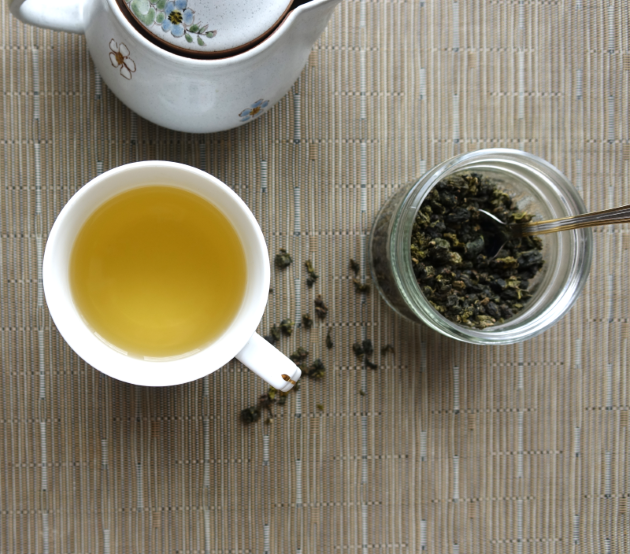Unlock the secrets to making green tea recipe perfectly with our easy-to-follow guide. Learn the ideal green tea temperature and precise steeping time to avoid bitterness and brew a flavorful cup every time. This simple green tea recipe ensures you master how to make green tea drink at home, explore delicious variations like green tea with lemon, and understand its potential benefits.
- Three tsp. of green tea pearls or leaves
- One tbsp. of fresh lemon juice (optional)
- One cup of filtered water
- Teacup (for drinking tea).
- Teapot (for brewing and pouring tea).
- Tea strainer (for separating tea leaves from liquid).
- Teaspoon (for stirring or measuring tea leaves).
- Cool the Water: Don’t use boiling water directly on green tea leaves, as it can make the tea taste bitter or burnt. Boil your filtered water, then let it sit for about 1-2 minutes off the heat before pouring it over the leaves. This slight cooling helps bring out the best flavor.
- (Optional) Quick Rinse: Place your loose leaves in the teapot or infuser. Pour just enough of the slightly cooled hot water to cover them, swirl gently for a few seconds, and then immediately discard this water. This helps to “wake up” the leaves and wash away any dust.
- Steep Gently: Pour the rest of the slightly cooled hot water over the rinsed leaves.
- Short Steeping Time: Green tea doesn’t need long to brew. Steep for only 10-15 minutes. Start tasting after 15 minutes. If you like it stronger, let it steep a bit longer, but be careful – over-steeping causes bitterness.
- Add Lemon After Brewing: Once the tea is steeped to your liking and you’ve removed the leaves (or poured the tea into your cup), squeeze in fresh lemon juice.
- Start Small with Lemon: Add just a small squeeze of lemon at first. Taste it, and add more if you want a stronger citrus flavor. Too much lemon can overpower the delicate green tea taste.
- Enjoy the Combo: The brightness of the lemon complements the green tea nicely, cutting through any potential grassy notes and adding a refreshing zest.
- Use Fresh Leaves: For the best taste, use fresh, good-quality loose-leaf green tea.
- Before thermometers, observing the water itself was key. Steam, the water’s visible breath, tells a story about its heat.
- The Fierce Breath (Full Boil): When water reaches its peak heat, a rolling boil, the steam is abundant, powerful, and turbulent. A thick, vigorous cloud rushes eagerly from the kettle’s spout or the pot’s surface. This untamed heat is often too harsh for delicate leaves.
- Taming the Heat (Cooling Begins): To prepare water for something gentler, like green tea, bring it to that fierce boil first. Then, remove it from the heat source and watch it patiently.
- The Calming Breath (Ideal Range Approaching): As the water rests and begins to cool, the character of the steam changes. The initial fierce rush lessens. The steam becomes less dense, less forceful. It rises more gently, seeming softer and calmer. It’s no longer an angry plume but a more peaceful presence ascending from the water.
- The Gentle Whisper (Ready for Delicate Leaves): When the steam has noticeably lost its boiling intensity and rises in this softer, calmer manner, the water has likely cooled enough. It retains significant heat – enough to brew effectively – but has shed the harshness that can scorch tender green tea leaves and create bitterness. This gentler state is what you seek.
- Learning to read the steam’s language requires practice and attention. Watch how it transforms from the wildness of the boil to a calmer state as it rests. This observation is the heart of the traditional method, connecting you directly to the water and the brewing process.
- Adding lemon juice to your green tea is a popular choice, and for good reason! It’s not just about enhancing the flavor, but also about boosting the health benefits and overall enjoyment of your tea time. Here’s why you should consider adding a squeeze of lemon to your next cup of green tea with lemon:
- Balances Bitterness: The tartness of lemon helps to balance the sometimes bitter or grassy notes of green tea, making it more palatable and refreshing.
- Adds Zest: The lemon juice adds a bright, citrusy flavor that complements the natural taste of green tea, creating a more complex and enjoyable tea-drinking experience.
- Boosts Catechin Absorption: Green tea is rich in catechins, an antioxidant linked to numerous health benefits. The vitamin C in lemon juice can enhance your body’s absorption of these valuable catechins.
- Preserves Antioxidants: The acidic environment created by lemon may help protect the antioxidants during digestion, allowing your body to utilize them more effectively.
- Combined Benefits: Both green tea and lemon are known for their health benefits. Green tea has been linked to improved heart health, increased fat-burning, and enhanced brain function. Lemon, a good source of vitamin C, is known for boosting the immune system and improving skin health. Combining them may offer a synergistic effect, providing even more benefits.
- Alkalizing Effect: Despite its acidic taste, lemon is considered alkalizing in the body, meaning it can help balance your body’s pH levels. Adding lemon to your green tea may contribute to this alkalizing effect.
- Improved Iron Absorption: Lemon juice can enhance the absorption of non-heme iron (the type of iron found in plant-based foods), which is especially beneficial for vegetarians and vegans.
- Soothes the Throat: Many people find that drinking warm beverages with lemon can be soothing for the throat.
- Adding lemon juice to your green tea is a simple yet effective way to enhance the taste, boost the absorption of beneficial antioxidants, and potentially increase the health benefits. It’s a small addition that can make a big difference in your tea-drinking experience!
Note: While green tea and lemon offer potential health benefits, this information is intended for general knowledge and informational purposes only, and does not constitute medical advice.

